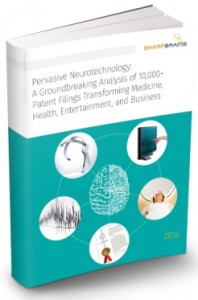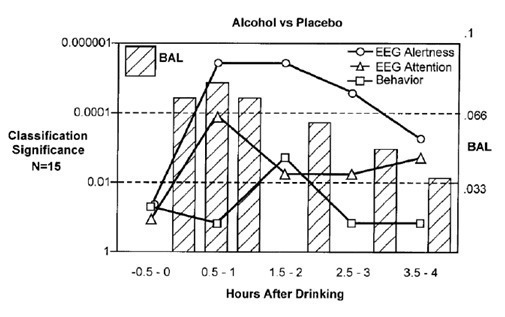Neurocognitive ability EEG measurement method and system: Key Neurotech Patent #8
Today we are sharing a 2002 patent assigned to Sam Technology, Inc.
U.S. Patent No. 6,434,419: Neurocognitive ability EEG measurement method and system
- Assignee(s): Sam Technology, Inc.
- Inventor(s): Alan S. Gevins, Michael E. Smith
- Technology Category: EEG
- Issue Date: August 13, 2002
SharpBrains’ Take:
The ‘419 patent describes systems with the objective of measuring cognitive ability through EEG signal detection and analysis, such that capabilities can be objectively measured in a manner that does not suffer from drawbacks associated with other cognitive assessment testing approaches that may present prejudicial assessments due to cultural biases and specific knowledge areas associated with the test subject. Moreover, the ‘419 patent recites an objective of measuring cognitive ability as it relates to external factors that may affect cognitive performance for better or worse, for example with cognitive performance after sleep deprivation. The significant EEG research data collected on the impact of cognitive performance under various mental states, such as drunkenness shown in the illustrative image above, and independent claim scope covering the inventive concept relating to objective cognitive testing, are amongst the factors making the ‘419 patent a key non-invasive neurotechnology patent.
Abstract:
An efficient, objective testing method and system for evaluating mental acuity and changes in mental acuity is described. The method and system are based on measuring an individual’s behavioral responses and brain function during a brief test of working memory and passive control condition. The method and system is designed to assess an individual’s overall cognitive ability (“general intelligence”), and whether that overall cognitive ability has been significantly affected by a variety of factors such as progressive disease processes, medication, stress, fatigue or training. The method and system can be used to determine whether drugs being evaluated to treat diseases or conditions affecting higher cognitive brain function have a significant positive effect on delaying or improving the symptoms of such a disease or condition, especially during clinical trials for drug approval and subsequent marketing. The method and system may also be employed as part of the successful diagnosis or ongoing treatment of neurological diseases or conditions that directly or indirectly affect human neurocognitive performance. The method and system may also be used to determine transitory changes in overall cognitive ability due to emotional stress or fatigue, and more long lasting changes in overall cognitive ability following training and educational programs.
Illustrative Claim 1. The method of measuring a subject’s working memory, substantially free of bias from cultural and educational experience, to determine the subject’s overall cognitive ability (“general intelligence”), including the steps of:
- (a) presenting an attention-demanding task to the subject, which engages the subject’s working memory processes, and, simultaneously;
- (b) measuring the subject’s behavioral responses to the task and neuroelectric activity at the subject’s scalp using a set of electroencephalograph (EEG) electrodes and amplifier and analog/digital(A/D) converters to provide a set of digital data representing the subject’s behavioral responses and neuroelectric activity in response to the task;
- © in a computer system, comparing the subject’s digital data representing behavioral responses and neuroelectric activity in response to the task to a set of digital data representing the behavioral responses and EEG derived neuroelectric activity responses of a normal group to the same task; and
- (d) displaying the subject’s overall cognitive ability score or scores based upon the comparison of © with the normal group.
 To learn more about market data, trends and leading companies in the digital brain health space –digital platforms for brain/ cognitive assessment, monitoring and enhancement– check out this market report. To learn more about our analysis of 10,000+ patent filings, check out this IP & innovation neurotech report.
To learn more about market data, trends and leading companies in the digital brain health space –digital platforms for brain/ cognitive assessment, monitoring and enhancement– check out this market report. To learn more about our analysis of 10,000+ patent filings, check out this IP & innovation neurotech report.



